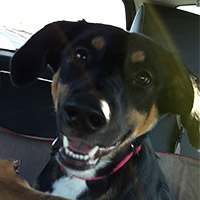Visualizing dog behavior as a stream of 1’s and 0’s that you can interact with and alter over time
I have a tendency to associate “no” only with truly bad behavior whereas I use “good” more ambiguously. There is also a third adjective describing “neutral” responses which may include you exchanging looks with your dog, but that involves no reaction or commands. These statements define an invisible boundary in our world that your dog navigates. I like to think of it as binary with 0 = off = bad and 1 = on = good. In every moment, there is a continuous string of 1’s and 0’s being activated and deactivated in the space around you by the decisions your dog is making. You define the path it takes by instructing it. As your dog looks towards the garbage, a good trainer has identified an early point to ensure the dog doesn’t consider that an option. As it stares and starts to move forward the 1’s turn to 0’s and the dog reacts by changing focus or backing off. Not because it understands that going in the trash is bad, but because it “feels” or remembers the negative association. If the dog hasn’t been properly instructed though then it remains as 1’s and the dog is free to move forward into the trash beyond the barrier you failed to construct into new territory not previously defined by your rules. It’s basically a changing data stream with clear definitions of what is good and what is bad. If there is ambiguity, then the dog won’t know and maybe that’s where we get into neutral territory or just a mix of 1’s and 0’s the dog can’t properly interpret. In a more simple sense, what I’m talking about is clear, unambiguous language about what you want from your dog. Early on I was saying things like, “don’t do that,” “hey,” “cmon,” pay attention,” etc. These are too complex and don’t clearly define what it is I want my dog to do. If Ellie is standing near me and wandering around and sniffing she’s in neutral territory, but as soon as she steps too far away it’s a clear “no” command or 0. If she returns it’s a clear “good” command or 1. I try to refrain from saying things like “come back” or “hey, too far.” Human language is too ambiguous to an animal. Instead, “no” should create a clear boundary around “good” territory your dog can operate within.
The initial difficulty I faced with this was changing my perspective about what “no” meant. “No” was supposed to be an extreme, a truly bad behavior I didn’t want and most situations don’t warrant that reaction. But as I changed how I thought about it, “no” needed to become more common. In fact, it needed to become almost as common as “good” because the two define each. If most everything is “good” and only some rare occasions are “bad” then there is a lot of undefined territory the dog can navigate through without limits. To make this work I realized that subtle behaviors needed to be controlled instead of just major “good” and “bad” events. Ellie ran across the street a few times to meet another dog and was punished afterwards, but before that there were cues about the impending behavior. Those also needed to be defined with “good” and “bad” directives. Heightened interest in the other dog, shifting her body away from me, deviating from the walk, not listening to my commands, and then moving toward the other dog are all events which “no” can be used to further mitigate the risk of running across the street. All of them are bad, but the dog doesn’t know it if you don’t define them. On the flip side, I want Ellie to sniff around and be curious, I want her to chew on a stick and run around happily, I want her to be as free as possible. This is why I mentioned neutral behavior as well. This third type of behavior doesn’t necessitate a response. It is not something good you want them to do continuously or bad and want them to avoid, but it is within the territory of good behavior.
To successfully accomplish this you need to be aware and reflect on the behaviors and actions your dog takes. You need to recognize subtle cues that led to bad behavior and further sculpt the boundaries that mitigate them. Mastering this can also present a visual tool to better understand your furry friend and make wise training decisions on the fly. It may also help explain why your dog does what it does and why it doesn’t understand certain other things. It can also open the door to a more healthy relationship and a more realistic perspective of how they think.
Additional note: along with unambiguous language, this method encourages rigorous consistency. If you allow your dog to be bad sometimes, but not others, there will be a confusing mix of 1’s and 0’s you’re relying on them to interpret properly. If, however, you work to ensure paths and boundaries are clearly defined and very consistent, there will be little error your dog can make.
